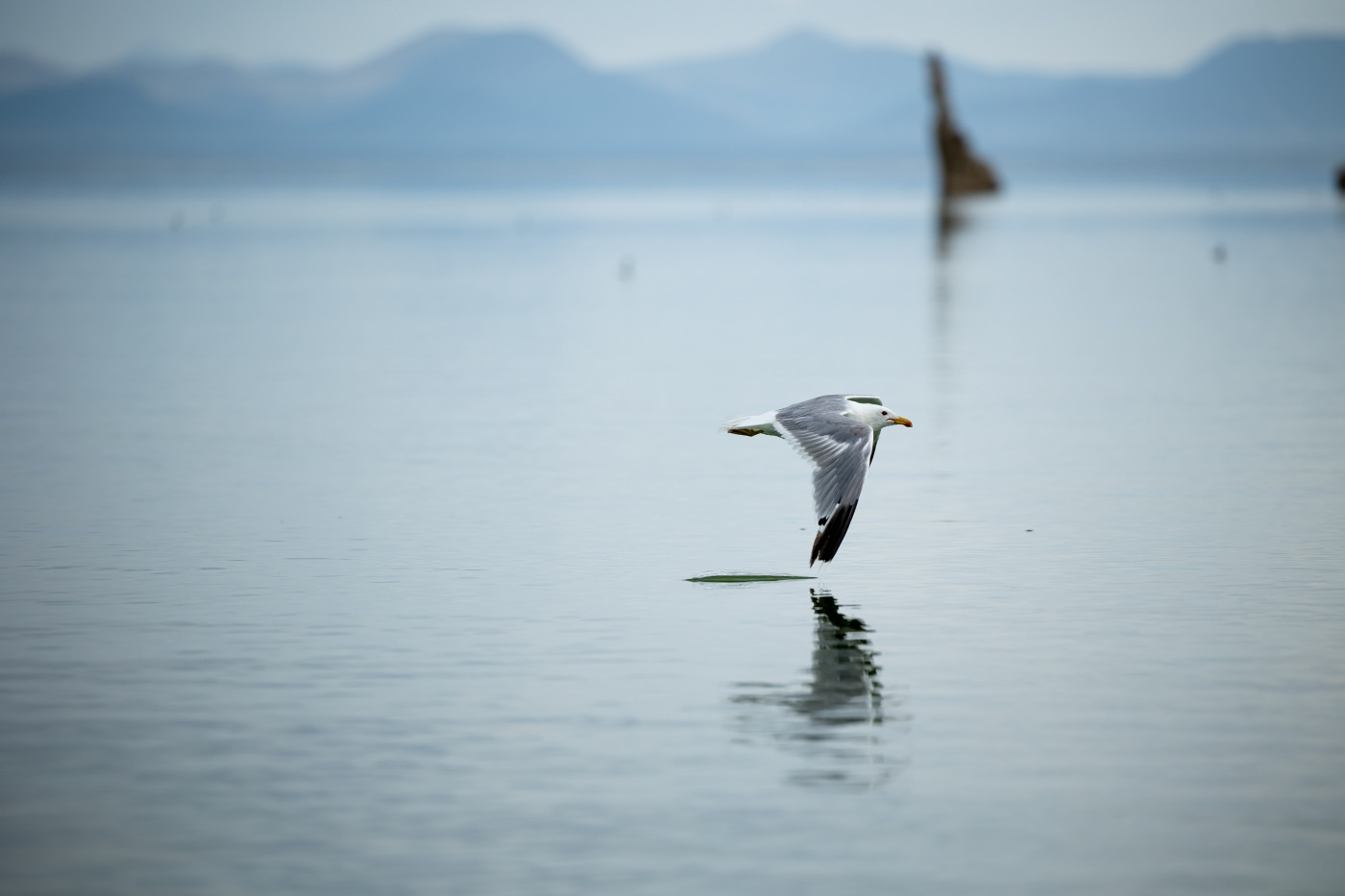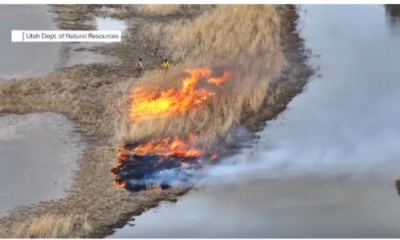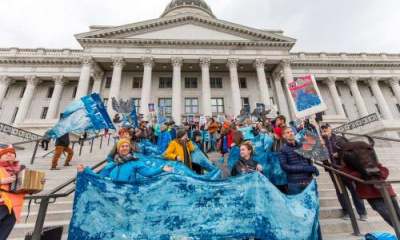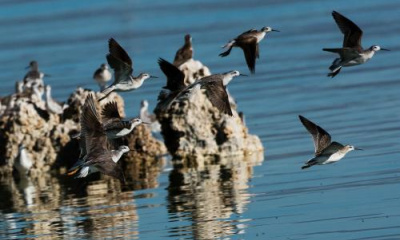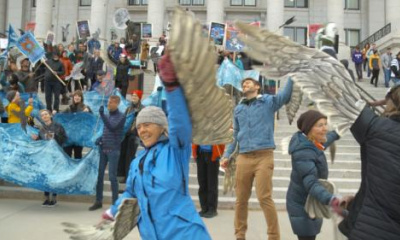This Great Salt Lake Collaborative story is part of day one of our series, “At water’s edge: Searching for solutions at the Great Salt Lake’s sister lakes across the Great Basin.” The in-depth project features the work of multiple journalists from multiple Utah news organizations.
Click here to learn why we went to California and to experience photos, videos, interactive maps and stories:
VISIT INTERACTIVE PRESENTATION »
Farmington Bay • Where tributary rivers meet the Great Salt Lake’s saline shores, the merging of fresh and salty water creates an oasis of life.
The river deltas form wetlands that provide refuge and forage for wildlife, as well as natural filtration systems and flood control for nearby urban population centers. The blending waters spawn a productive environment for bugs and other invertebrates that ibises and ducks and gulls eat. The mixture sometimes smells infamously pungent, but it’s a soupy feast for fowls.
“Especially for shorebirds, it’s really viewed as irreplaceable,” said Marcelle Shoop, director of the Saline Lakes Program for the National Audubon Society, “because there aren't many habitats out there like that, where you have the transition of wetlands and shallow water to deeper water and a range of food sources.”
And the Great Salt Lake isn’t the only saline lake in the West providing this critical avian staging ground. The entire Great Basin has a constellation of terminal waters that help guide migrating birds on their long journeys across the hemisphere.
Some fly in from as far away as Tierra del Fuego in South America to the snowy Arctic up north.
But terminal lakes are under threat from drought, climate change and water diversions. Owens Lake in California was one of the first to wither completely, drained by the Los Angeles Aqueduct. Mono (pronounced “moan-oh”) Lake, which also lies in the eastern Sierra, was headed down the same path and has yet to recover. In 2014, Oregon’s Lake Abert dried up, likely due to nearby farmland irrigation.
The Great Salt Lake is following a similar downward spiral. It sank to a record low last year, then another in July, its elevation continuing to drop nearly every day since.
Alarmed by the trend, Audubon conducted a study in 2017 of these saline lake systems to understand their current status and how their fates are linked.
“If you watch what was going on with these lake systems over the years, what we could see is a continuing decline in water resources,” Shoop said. “… [But] nobody was thinking about these lakes at the landscape level.”
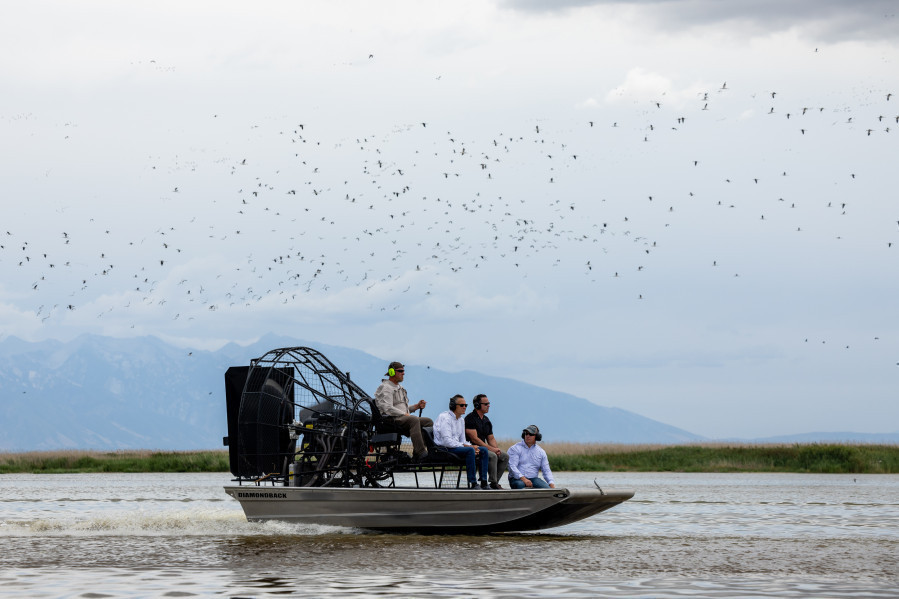
Chad Cranney, assistant wildlife manager for the Utah Division of Wildlife Resources, pilots a fan boat carrying Sen. Mitt Romney, R-Utah, Utah House Speaker Brad Wilson, R-Kaysville, and Utah Rep. Joel Ferry, R-Brigham City, left to right, on a tour of the Great Salt Lake in Farmington Bay on Friday, Aug. 19, 2022. Spenser Heaps, Deseret News.
State of the Great Basin’s birds
The nonprofit’s assessment, called “Water and Birds in the Arid West: Habitats in Decline,” found the Great Basin’s saline lakes support millions of migrating birds. Around 99% of eared grebes, 90% of Wilson’s phalaropes and 50% of the American avocets in North American rely on the saline lake network.
But more than half the region’s salty lakes have shrunk by 50% to 95% over the past 150 years. And shorebird populations have plunged by 70% since the 1970s.
“If we don't protect these systems, that is going to have a substantial impact,” Shoop said. “We just can't afford to have more species disappearing from the earth.”
While some might not have much interest in the charismatic birds these systems support, their decline signals a threat to everyone and everything living in the Great Basin.
“Like the canary in the coal mine, it’s the first indicator of where we’re going as humans,” said John Luft, the Great Salt Lake ecosystems program manager for the Utah Division of Wildlife Resources.
He’s already seeing impacts of record-low water on the Great Salt Lake’s avian inhabitants. Nearly every species has taken a hit.
Northern shovelers, Luft said, typically feed on the seeds washed into the lake’s bays by rivers like the Bear and Weber. Now those rivers are getting sucked dry before they reach the lake. The seeds aren’t coming. The ducks are starving.
As winter sets in and wetlands freeze, some birds move to the lake to forage since its salty water has a lower freezing point. But the microbialite structures that support bugs and brine fly larvae have surfaced and died. That’s led to a decline in common goldeneye duck populations.
When the water shrivels at one saline system, some birds might be able to move and get by at another. But what do they do when everything becomes desiccated?
“It’s an arid desert region,” Luft said, “that has stopovers that are few and far between.”
He likened it to driving from Salt Lake City to Wendover on an empty tank, expecting to refuel at the one gas station along the way — the lonely Delle City Station in Skull Valley.
“But you get there and there’s a whole line of cars, and they’re only giving you one gallon,” Luft said. “You have to start to think, ‘Do I have enough with this one gallon to make it? Where do I go at this point?’”
‘These birds connect us’
Salty lakes have their protectors. Many have come to realize that in the arid West, every drop of water counts.
Mono Lake was among the first, where the Mono Lake Committee organized and won legal tussles to ensure the lake, someday, reaches a sustainable level.
“When you think that every drop of water matters, it's not only for Mono Lake,” said Rose Nelson, education director for the committee. “These birds connect us to this entire hemisphere. … These birds really tie us together.”
Even at the dry salt flat that was formerly Owens Lake, conservation efforts have slowly revived the bird habitat. In 2018, Owens Lake joined the Great Salt Lake and Mono Lake in the Western Hemisphere Shorebird Reserve Network, recognized for its crucial habitat.
“We’ve had over 100,000 birds on the lake in a single day, which is an enormous amount of birds,” said Mike Prather, an Audubon volunteer. “There are very few places on the planet where you see that kind of wildlife. It’s a world-class situation.”
The Great Salt Lake is by far the largest and most bird-abundant saline lake in the West. It has long had its own advocates, but Utah lawmakers are just now awakening to the lake’s dire straits.
Earlier this year, they approved a $40 million trust to improve the lake’s wetland habitat and secure it more water. They’re also experimenting with water banking, split-season water rights leasing and secondary metering to help funnel more water to the parched lake.
While most water management happens locally, saline lake advocates are lobbying at the federal level as well, helping policymakers understand how the network of saline lakes works in concert.
Last summer, the U.S. House passed the Saline Lake Ecosystems in the Great Basin States Program Act as part of its larger Wildfire Response and Drought Resiliency Act. The bipartisan legislation, co-sponsored by Rep. Blake Moore, R-Utah, would peg $25 million for a comprehensive evaluation of the region’s saline ecosystems.
“I know people want action, not studies,” Shoop said. “The importance of this, though, is identifying where there are gaps and things we need to do and … the kinds of actions to take.”
A counterpart bill, sponsored by Sen. Mitt Romney, R-Utah, awaits a vote in the Senate. But Shoop said the West’s current “megadrought” has lawmakers’ attention.
“There's a recognition that we do need to do something, and we need to do it now,” Shoop said. “We can't wait any longer.”
What's your response to At Water's Edge?
Does this reporting project make you feel hopeful? Concerned? Inspired? Surprised?
Selected responses will be used on social media, on our website or in our newsletter.

